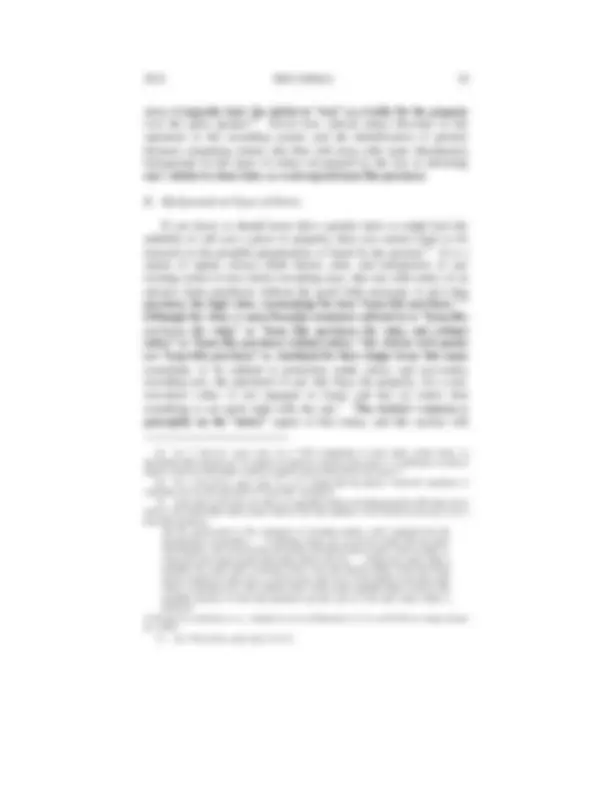























































Study with the several resources on Docsity

Earn points by helping other students or get them with a premium plan


Prepare for your exams
Study with the several resources on Docsity

Earn points to download
Earn points by helping other students or get them with a premium plan
Community
Ask the community for help and clear up your study doubts
Discover the best universities in your country according to Docsity users
Free resources
Download our free guides on studying techniques, anxiety management strategies, and thesis advice from Docsity tutors
An organizing principle of the rule of law based on individualism and order is expressed by the Latin maxim nemo dat quod non habet.
Typology: Lecture notes
1 / 61

This page cannot be seen from the preview
Don't miss anything!






















































Donald J. Kochan*
I. INTRODUCTION
An organizing principle of the rule of law based on individualism and order is expressed by the Latin maxim nemo dat quod non habet (hereinafter nemo dat for shorthand)—roughly translated to mean that one can only give what they have or one can only transfer what they own.^1 It is a matter of only being permitted to do what is within your legal authority to do. I should not be able to sell you a house after I sold it to someone yesterday (even if I at one earlier point owned the house) any more than I could sell you the Golden Gate Bridge (which I do not and never did own). My lack of authority in each should be the same. Once I have sold the thing I previously owned, my right to sell it should be irrevocably lost, and the property should no longer be mine to sell any more than selling something I never owned at all. This seems simple enough, but the law is seldom so easy. Markets never operate quite so mechanically, and sellers of real property sometimes behave badly (in other words, sell property twice or more) instead of behaving benignly and in compliance with the nemo dat limitations on what one should be allowed to do. Instead of operating with a hammer when it comes to sales of
2 KANSAS LAW REVIEW Vol. 64
property without authority, the law tolerates some curious deviations from our expected or desired adherence to the nemo dat paradigm in order to advance other policies, including fairness and certainty of title.^2 “Ownership” is more textured than one might immediately appreciate. With the aid of property recording acts, it becomes true that, in function, indeed one can sometimes sell more than they “own.” In this Article, the term “dirty deeds” shall take on two related meanings. One, it will represent those deeds (documents) that have been marked, or dirtied, by the first sale so that once they get to the second purchaser they are no longer clean and no longer entirely free for the taking. It shall also represent deeds (as in actions) that are disfavored, disagreeable, and harmful, against which we seek protection and deterrence to minimize their occurrence. Consider the following example in which dirty deeds and nemo dat exceptions collide. In most jurisdictions, a grantor X might sell Blackacre to person Y and then later sell to person Z , and Z might be awarded the title to the property so long as Z is a bona fide purchaser without notice of the previous conveyance to Y —even though Z might take the land by what we could call a “dirty deed” (here used in the document form)—where the deed is soiled by its previous conveyance to Y rather than being pure, clean, and fit for conveyance to Z ; the deed seemingly represents property spoiled and incapable of being passed to others because it is already sold to another; and the deed is transferred
4 KANSAS LAW REVIEW Vol. 64
achievement of) the maxim. That introduction leads to Part III, which is intended to provide a valuable summary of the recording acts and their purposes, along with the types of notice and their uses, while exposing the tensions these recording systems each have with a strict notion of nemo dat. Part III will also do a comparative assessment of different types of recording regimes in light of these realities, identifying which are better at navigating these tensions. Part IV returns to those tensions in detail and explains the purposes of the recording acts and why the protections for bona fide purchasers are necessary to facilitate markets in property and serve other goals. It reveals what might be called the impossibility of fully enforceable property rights in real property. It draws on case examples—where tough choices necessitate choosing certainty over protecting initially conferred “rights”—to reflect on why we make such choices. Part IV also explores the role of individual responsibility—particularly as it relates to purchaser obligations to record and examine records—as the core justification for setting the rules in a manner that may result in first- in-time titleholders sometimes losing out to subsequent purchasers. Finally, Part IV concludes with a defense of the proposition that, despite our recognition of some exceptions from nemo dat , the law should constantly strive to develop in ways that can better approximate full adherence to a nemo dat ideal. This Article contends that we should structure our property law based on a preference for achieving the nemo dat ideal as closely as possible, understanding that pragmatism concerns do in fact make some exceptions necessary while also appreciating that we should find ways to minimize the need for invoking such exceptions and reduce the need to rely on such second-best solutions to dirty deeds. Without changing criteria for the exceptions, we can change the access to information and the speed of its flow to shrink the pool of those who fit the criteria for the bona fide purchaser exception. This would not be done by changing the nature of the protections available to innocent bona fide purchasers but instead by finding new ways to inject more information about land conveyances into the public view—beyond traditional recording mechanisms—so that more and earlier notice of possible competing property claims is available to responsible purchasers exercising due diligence. To accomplish that goal, this Article concludes in Part V with one proposal that aims to take advantage of what I call the underexploited utility of “inquiry notice.” The idea is to create better conditions to give first-in-time purchasers additional opportunities to protect their title interests by more easily triggering the inquiry obligations of second-in- time and other subsequent purchasers. This Article outlines the
components of a proposed new and innovative service that I call the “Title-Related Inquiry Notice Triggering System” (TINTS). As outlined, TINTS would operate in a manner that would provide a means for purchasers of property to protect their claim to title even earlier than official recording might accommodate. Taking advantage of modern technology with near-instantaneous uploading of information into the publicly available TINTS, purchasers can notify the world of the existence of their claim to a particular piece of property immediately upon the completion of a conveyance from the grantor. Through the development of custom, or perhaps by statutory mandate, it could become common practice for all purchasers to also access TINTS and search for potentially competing claims to the same property. Part V acknowledges potential risks of abuse in such a system like TINTS that could themselves have market-disrupting effects. It offers some starting suggestions for controls against such risks, while explaining the market-facilitating benefits from a system like TINTS. In the end, we should find ways to strengthen the law’s ability to make and defend the claim more frequently that one truly cannot sell what they have previously sold. TINTS, or other innovations like it, can assist us in matching these nemo dat preferences with property law pragmatism. Maximizing the consonance of outcomes in real world title contests with the nemo dat ideal should be a goal of the property system.
II. A BRIEF INTRODUCTION TO THE NEMO DAT PRINCIPLE AND ITS PLACE IN REAL PROPERTY LAW
As stated at the top of this Article, the Latin maxim nemo dat quod non habet —one cannot give what they do not have (or, you have to have it to give it)^4 —holds a special place in our law. The nemo dat principle is so strong that it has broad applications associated with the transfer of most assets, not just real property.^5
ownership.^10 Do the exceptions to nemo dat also make sense? To a degree, I think the answer is a clear yes. But those exceptions require more explanation, especially because they must overcome this intuitive, common sense belief^11 that no one should be able to sell the same thing twice. The application of nemo dat , however, cannot in modern law be divorced from the necessity of standards for setting priorities between multiple innocent claimants rather than simply applying a priority-by-time-of- conveyance rule.^12 The next Part will give readers the background necessary to understand how the law has come to develop these recording and title priority rules. The rules discussed are normally just referred to as basic rules of recording real property interests. Yet these rules take on a new meaning and understanding if they are framed as exceptions to, and pragmatic tools for the management of, the nemo dat principle and as considered deviations away from the nemo dat preference.
III. BACKGROUND: BASIC TERMINOLOGY AND DOCTRINE FOR RECORDING ACTS AND NOTICE MECHANISMS
Before reaching the heart of this Article’s assessment of the reasons to adhere to a nemo dat principle and the reasons for its exceptions, this Part will provide some basic terminological and doctrinal background to orient the reader to the various types of recording statutory regimes and how they operate. Most of the discussion regarding why these systems operate as they do and the purposes of recording will be saved for later Parts in this Article. For now, the purpose will be to make sure all readers have a basic understanding of the recording system and the types of notice recognized by the law within that system.
8 KANSAS LAW REVIEW Vol. 64
A. Types of Recording Statutes
When two or more individuals make claim to the same piece of property, rules must be established to resolve these competing claims. The following sections will evaluate four basic types of jurisdictional approaches to this problem: (1) no recording statute and instead where common law principles of first-in-time prevail; (2) “race” recording statutes; (3) “notice” recording statutes; and (4) “race-notice” statutes.^13 In each of these cases, we are concerned with a competing claimant other than the grantor, i.e. two different purchaser-grantees. Because a grantor and grantee are parties to their own conveyance, their respective rights vis-à-vis each other will be judged by the terms of the conveyance. Resolution of competing claims between those parties will be resolved based on the documents and circumstances surrounding their transaction rather than on the recording rules of the jurisdiction. An unrecorded deed is still valid and binding as between those parties to a conveyance of the property (and does so even in the face of statutory language that appears to claim only recorded deeds are “valid” because, under those statutes, the validity is being judged only with regard to subsequent purchasers).^14 This Article’s major concern lies outside that initial relationship and instead focuses most of its attention on disputes between multiple purchasers claiming to hold title to the same property. Today, all states have some type of recording act and none rely on common law rules alone for the priorities between successive purchasers.^15 Very few states use pure race rules,^16 while the remainder
10 KANSAS LAW REVIEW Vol. 64
same property twice and commit fraud, such second sale will not have legal effect and will not subordinate the first purchaser’s rights to the property. It is precisely the possibility of fraud and the way it was encouraged under these common law rules—because there was no definitive records office to verify claims, requiring multiple claimants to expend money proving their case for priority based on developing an evidentiary record that they were first in time—that led to substantial criticism of the system and motivated the adoption of recording laws as providing more effective verifiability systems.^23 Without recording provisions and effect given to the act of recording, individuals were easily duped into buying property that had already been sold to another because there was no way to check and verify the existence or non-existence of competing claims. The move toward recording regimes was designed, in part, to resolve that issue of undetectability.^24 Recording helps provide evidence of a superior claim to the world, or at least helps define the meaning of “superior” in a manner accompanied with mechanisms to verify that priority. Recording is the method by which modern purchasers vaunt their claim to newly conveyed property and serve public notice, which takes the place of less transparent and verifiable means of proof.^25 With the passage of recording acts, the states have replaced the common law priority rules with laws that require either some step beyond conveyance or, at the very least, an additional metric of notice to come into play before determining which grantee receives priority in a title contest.^26 In other words, in every state in the United States, it is now usually no longer enough to simply be the first party to be conveyed property in order to win in a title contest.^27 Of course, in those situations where recording acts exist but no claimants (original or subsequent) take advantage of them—i.e. when neither party can fit into the safe harbor that a recording system typically provides—the parties are defaulted
back into a first-in-time resolution of a title dispute. Without a recording system, a purchaser would be entirely dependent on the assurances of the vendor of the property—a situation that is rife with the potential for abuse.^28 After all, what incentive would there be for a vendor to disclose the existence of prior competing interests? The recording system seeks to provide an institutional correction and a market-enhancing mechanism to defeat those temptations to commit such dirty deeds. A primary purpose of recording is to create official public records that protect buyers “against any competing claims that may be created by the grantor in others”^29 and to influence the behavior of owners (and their lawyers and other representatives) in a way that motivates the creation and transaction of title that is as clean as possible. The next subsections outline the three jurisdictional models adopted in various states. Through application of each of these recording acts in their own way, it can be said that particular individuals will “win” in some contests based on operational exceptions to the nemo dat principle. All of the recording acts at least diminish the nemo dat principle’s power as a controlling influence in title disputes.
In the very few jurisdictions that have chosen to operate under a “race” statute, the idea is simple: when there are two competing successive purchasers of a particular piece of property, the first to record his interest is awarded the property because he has won the race to the recording office.^30 To see how a race statute is typically worded, consider the following language from the recording laws of North Carolina:
§ 47-18. Conveyances, contracts to convey, options and leases of land
purchasers without notice are valued less in pure race jurisdictions.^34 Neither time of conveyance nor whether either party had notice of the other party matters in a pure race jurisdiction.^35 Thus, even a second purchaser who knows of the first purchaser can prevail.^36 For this reason, some see pure race as unfair, explaining also the popularity of the other two regimes: notice and race-notice.^37 In contrast to pure race regimes, the idea behind notice and race-notice alternatives is to protect bona fide purchasers who take from grantors and, by no fault of their own, have no idea that another party has been previously sold the property.^38 On the other side of the coin, another related purpose is to avoid rewarding later purchasers who know the grantor has already sold the same property to someone else.^39 In other words, these other models protect a bona fide purchaser for value and without notice—someone who has no reason to question the authority of his grantor to sell the property in question^40 —while race is indifferent to such a complexion. The recording laws have developed in most jurisdictions under models that care about such purchaser characteristics.^41 With slight variation between them, these two notice-based models shield those later purchasers who have an honest belief in the legitimacy of the real property transaction to which they become a party,^42 as the next two subsections detail in turn.
14 KANSAS LAW REVIEW Vol. 64
Pure notice jurisdictions^43 focus on just that—notice.^44 In a pure notice jurisdiction, a subsequent purchaser who takes a property without notice of the prior claimant will win, in essence, invalidating or subordinating the rights of the prior grantee.^45 Some phrase the notice jurisdiction rules as meaning this result occurs regardless of who records first, and that phrasing has some merit.^46 But, while that may be technically true, it is always the case that if the first grantee records before the conveyance to the subsequent grantee, then the subsequent grantee will be on record notice of the prior grantee and will not be in a position to invalidate the prior grantee’s claim.^47 In other words, if the subsequent grantee has notice—record or otherwise—of the earlier conveyance then that subsequent grantee cannot take priority. A typical notice jurisdiction will have language in its recording act similar to that used in Kansas: “No such instrument [conveying or affecting real estate] in writing shall be valid, except between the parties thereto, and such as have actual notice thereof, until the same shall be deposited with the register of deeds for record.”^48 Recording itself ensures that all parties will have notice of the pre-existing claim and cannot claim to be without notice.^49 But until title is recorded, so long as a subsequent purchaser is without “actual notice” (which is a term that Kansas and other jurisdictions have generally interpreted quite broadly to include actual, implied, constructive, record, and inquiry notice^50 ) of the
16 KANSAS LAW REVIEW Vol. 64
the property is sold to a second purchaser without notice, the first purchaser (so long as he also had no notice of competing claims at the time of his purchase (which is subsumed if he is truly “first”)) still has a window to perfect his claim to title by recording before (and winning the race with) the subsequent purchaser.^54 California’s recording statute provides a good example of terms used to create a race-notice system:
Every conveyance of real property or an estate for years therein, other than a lease for a term not exceeding one year, is void as against any subsequent purchaser or mortgagee of the same property, or any part thereof, in good faith and for a valuable consideration, whose conveyance is first duly recorded, and as against any judgment affecting the title, unless the conveyance shall have been duly recorded prior to the record of notice of action.^55
In essence, race-notice jurisdictions protect those that are first to file so long as they are without notice of prior purchasers.^56 Consider the following example application. If the subsequent purchaser D takes without notice on Tuesday, then the earlier purchaser C (who was also without notice of competing claims) records on Wednesday, then the subsequent purchaser D records on Thursday, the result is that the subsequent purchaser D is too late in a race-notice jurisdiction. Despite his “innocence”—i.e. lack of knowledge or notice of the earlier claimant— D was not quick enough, and D loses. Note that in a pure notice jurisdiction, however, D would have won under the above facts (because he took without notice, including without record notice because at the time D purchased C still had not yet recorded). In order for D to win in the facts above, he would have needed to record sometime before C.
As mentioned above, despite variations in the language of some
investigate and ascertain the ultimate facts.” Id. at 170.
recording statutes, they (except for race jurisdictions) “almost invariably... have received the same construction, as affording protection to a subsequent purchaser only when he is without notice of the unrecorded conveyance.”^57 Under all of these variations on establishing priority, if a first-in-time purchaser acts responsibly and records, most often he will be protected.^58 Of course prudence dictates that one should immediately record, yet that may not be enough protection in every case. There may be gaps between the filing of a record and its effectiveness in the recording office that must be addressed and these are some of the concerns addressed later in this Article.^59 Nonetheless, the vast majority of interests can be protected against adverse claims by prompt recording no matter what jurisdictional rules apply—whether it is to win the race, to use the recording to provide notice, or to both provide notice and beat others (who are without notice) in a race to the perfection of one’s title. Once the first grantee files and creates record notice, he is protected against subsequent purchasers under both notice and race-notice regimes because all others will be put on notice of the competing claim^60 and therefore will be unable to meet the standards to be an eligible bona fide purchaser without notice^61 (and, consequently, will usually lose in a contest with a prior title claimant^62 ). Once title is recorded, the prior owner’s ability to successfully carry out a fraudulent re-conveyance without exposure and liability is severely diminished. This fraud-deterrence function is at least one rationale underlying the development of recording laws and bona fide purchaser protections.^63 The process of recording should capture and prevent most multiple sales from subordinating the first-in-time purchaser.^64 Nonetheless—whether it is because of errors in recording, gaps in
about it typically lacks the ability to “win” in a battle for the property over the prior grantee.^68 Given how critical notice becomes to the operation of the recording system and the identification of priority between competing claims, this Part will close with some introductory background on the types of notice recognized by the law as defeating one’s ability to claim status as a subsequent bona fide purchaser.
B. Background on Types of Notice
If you know or should know that a grantor lacks or might lack the authority to sell you a piece of property, then you cannot claim to be innocent in the possible perpetuation of fraud by the grantor.^69 It is a matter of equity, always (both before, after, and irrespective of any existing notice or race-notice recording acts), that one with notice of an adverse claim purchases without the good faith necessary to give that purchaser the legal status surrounding the term “bona fide purchaser.”^70 Although this status is more formally sometimes referred to as “bona fide purchaser for value” or “bona fide purchaser for value and without notice” or “bona fide purchaser without notice,” this Article will mainly use “bona fide purchaser” as shorthand for these longer terms that mean essentially: to be entitled to protection under notice and race-notice recording acts, the purchaser is one who buys the property, for a real, non-sham value, is not engaged in fraud, and has no notice that something is not quite right with the sale.^71 This Article’s concern is principally on the “notice” aspect of this status, and this section will
20 KANSAS LAW REVIEW Vol. 64
address the meaning of “notice.” Notice itself is a broad concept with a number of variations but each having the same essential effect.^72 Notice may include actual knowledge of, or actual notice of, a fact.^73 This means the purchaser not only had information available to him but he also knew of that information (e.g., he was told the fact, he read the fact in the records, etc.).^74 Note that our protection through notice requirements is aimed at protecting a purchase, and thus what matters most is the quantum of notice available at the time the purchaser must pay consideration for the property. Many courts hold that actual notice may be express or implied.^75 There is also the category of “record notice” (sometimes referred to simply as “constructive notice” even though it is only one of several types of “constructive” notice, as will be discussed in a moment) where the world is presumed to be on notice of all claims to title properly recorded and of any facts that may be included in the title, deed, and other documents filed in that record for a particular piece of property.^76 And, it is the responsibility of all purchasers to check the record before purchasing property, lest they risk losing to a prior titleholder of record. Some wonderful language on record notice exists to describe the benefits and purposes of recording in the 1881 U.S. Supreme Court opinion in Neslin v. Wells ,^77 which, surprisingly, turns out to be an inexplicably rarely cited opinion. Neslin is a case involving claims of priority lien status by a claimed prior mortgagee of the same land to which another mortgagee made a claim.^78 Because it is so instructive and has rarely received ink in legal commentary, it is worth quoting parts of that opinion at length. Faced with interpreting early Utah legislation that “did not require that a mortgage should be recorded in order to be valid, and did not in terms declare what should be the legal effect of recording or omitting to record it,”^79 the Court needed to set forth some general principles of notice that it identified as broadly applicable regardless of the type of